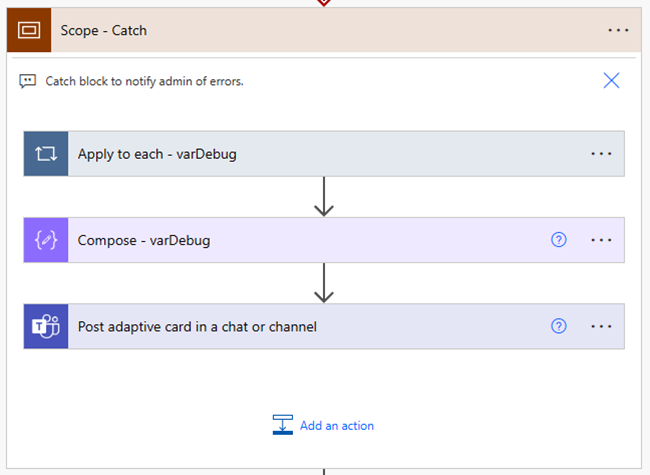When a record in Dataverse changes the updated value can represent a state change within a business process that needs to execute further action. Consider the Tasks table. If the Activity Status column value changes to “Completed” then notify the user who submitted the issue. In Power Automate we can support this type of process … Continue reading Take action based on value in a Dataverse column using Power Automate
Error handling in Power Automate using Adaptive Cards for Microsoft Teams
I’ve created enough Power Automate routines to know that they all eventually fail for some reason or other and it’s important to add resiliency to your production Flows where you can. This can include: Using service-accounts for your connections. This removes the impact of account actions like password changes or user deactivations. Adding co-owners to … Continue reading Error handling in Power Automate using Adaptive Cards for Microsoft Teams
Extract multiple lines of text from email using Power Automate
I recently encountered a scenario where I had to extract multiple lines of text from a system generated email using Power Automate. The key to this Flow pattern is the predictability of the system generated message, meaning I can count on line 1 always being line 1 and line 2 always being line 2 etc. … Continue reading Extract multiple lines of text from email using Power Automate
Get started with Dataverse Forms
One of the great values of using Dataverse Model-driven apps is the ability to use the out-of-the-box forms. These forms supply the user interface to the tables and data within our app and can be customized to meet requirements without having to learn code or incur technical debt. The out-of-the-box forms can be added and … Continue reading Get started with Dataverse Forms
How to create a new Dataverse Solution
In an earlier blog post, I wrote about Dataverse environments and how they are the container that stores the data, apps, processes, reports, and other components within a Dataverse solution. A Dataverse solution is the way that we package our application and all its parts into a single file that can be used for distribution or … Continue reading How to create a new Dataverse Solution
How to create a new Dataverse Environment
An environment in Dataverse is the container that stores the data, apps, processes, reports and other components within a Dataverse solution. A common use case for creating added Dataverse environments is to keep “production”, “test”, and “development” activities separated. In this blog post, we will walk through the steps of creating a new Dataverse environment and … Continue reading How to create a new Dataverse Environment
How to Get Started With Dataverse Solutions
This article originally appears on the AvePoint blog as How to Get Started With Dataverse Solutions. Dataverse is sometimes viewed as a database service, but it’s much more than just tables and views. Also included are apps, forms, processes, workflows, and other built-in and reusable objects that can be used to create and distribute applications. One … Continue reading How to Get Started With Dataverse Solutions
How to get a Power Apps Developer Plan
If you want to get started with Dataverse but do not have a license available get a Power Apps Developer Plan. The Developer Plan gives you Power Apps, Power Automate and Dataverse for non-production use. Learn more at: https://powerapps.microsoft.com/en-us/developerplan/ You have two options for signing up: Get started free, use this choice if are you not using … Continue reading How to get a Power Apps Developer Plan
Migrate Microsoft Lists to Dataverse for Teams
Despite this blog post’s catchy title there is no magic upgrade button to move Microsoft Lists to Dataverse for Teams. There may be in the future but until then migration translates to rebuild. A list rebuild to Dataverse will most likely be caused by a design requirement that Lists is not suited to, like setting … Continue reading Migrate Microsoft Lists to Dataverse for Teams
Export Microsoft List data to Excel
I've previously written about how to import data from Excel into Microsoft Lists. In this post, we will switch things up and export list data into Excel using Power Automate. In our scenario, we will export a subset of the list data into a date-named spreadsheet that is stored in Microsoft Teams daily. Excel Preparation … Continue reading Export Microsoft List data to Excel









